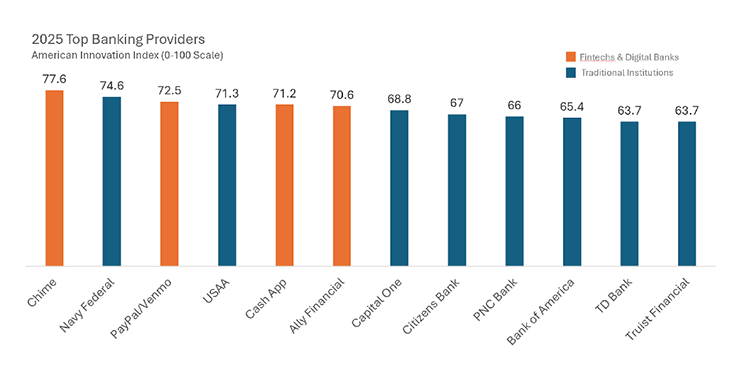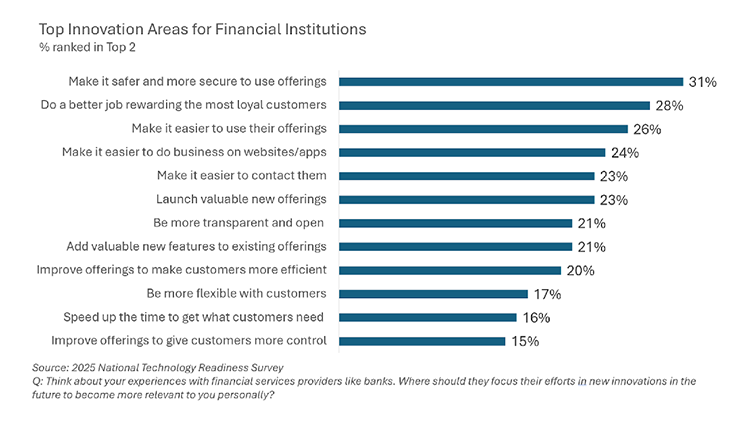While innovation is a goal for many financial institutions, the sector faces unique challenges including high regulatory and compliance hurdles, legacy systems that are difficult to modernize, and a culture that is risk-averse, hierarchical, and stability-oriented. These challenges stall innovation efforts and can make institutions question the value of their investments.
Reflecting these difficulties, it is not surprising that the retail banking industry is ranked one of the least innovative industries by its customers among the 16 industries tracked in our American Innovation Index™ study. It ranks 10th behind other traditional sectors, such as automotive, manufacturing, retail, hospitality, and technology. However, innovation is not impossible. Digital banks and fintechs perform far better than traditional banks due to their focus on redefining the financial services experience for customers. Member-focused providers like Navy Federal and USAA outperform traditional banks on innovation due to their personalized and empathetic approach to service delivery.

Why innovation matters for financial institutions
Customers expect more from the companies they do business with than a satisfactory experience, based on our analysis of the results of the American Innovation Index study, a joint research program with Fordham University’s Gabelli School of Business and Radius. Companies that engage in innovation resulting in a positive change in their products Global Market Research, and/or relationship with customers are more attractive to them. As a result, innovative companies are rewarded with greater customer loyalty, and ultimately, higher financial returns. When a company innovates and it is noticed by customers, it drives an 8% increase in shareholder wealth in the following 12 months on average.
Satisfying customers is critical to company success, but innovating is how a company will win in the long run. Our research shows that the most innovative companies are more likely to be disruptors in their sector, while the least innovative companies are at risk of being casualties of disruption.
Financial customer priorities for innovation
The upside of innovation is clear, but given the challenges, financial institutions need to prioritize innovation efforts in areas that will have the greatest impact. Innovation priorities will vary by financial institution due to its customers’ experiences with the institution, but we asked consumers where the industry should focus its efforts in developing innovations in a recent study (see chart below). Several key insights emerge:
1. Safety and security – Consumers’ top innovation priority for financial institutions is to make their products and services more secure so that customers can trust that their money and personal information are safe. Security is table stakes for financial institutions, and innovation efforts to support fraud protection and data privacy should be considered before moving forward with other innovation investments. These efforts need to be communicated to customers to have an impact on their innovation perceptions.
2. Rewards – Consumers want financial services providers to reward them for their ongoing relationships, similar to other companies they do business with, such as retailers, hotels, and airlines. Introducing innovative recognition and rewards programs to show customers they are appreciated can be a differentiator for financial services providers. Rewards programs can include relationship-based pricing with lower rates for long-standing or multi-product customers, as well as subscription memberships for bundled services. Recognition can be shown through VIP service tiers with dedicated account managers, or personalized communications highlighting customer tenure and other milestones.
3. Ease and convenience – Consumers value banking that is simple, fast, and adaptable to their needs. Institutions should strive to provide banking without friction, e.g., more intuitive apps, quicker problem resolution across service channels, faster transactions, and flexibility to fit individual circumstances. This is about saving time, reducing frustration, and letting customers engage with the institution on their terms.
4. Valuable new offerings – Consumers are looking for financial services providers to offer new products and services, as well as new features for existing products. Innovative institutions do both, layering new features onto familiar products to promote stickiness while launching entirely new offerings to expand relevance.
5. Transparency and flexibility – Consumers want financial services providers to act less like “black boxes” and more like trusted partners. Institutions should look to innovations like fee transparency tools, such as sending alerts before fees are charged and providing monthly fee report cards. AI can be used to predict and help overcome issues, such as communicating potential overdrafts and upcoming bills, to make customers feel they are in control and the institution is putting them first.

As you consider innovation strategies for your institution, the best place to start is with your customers. Understanding customer needs and pain points will ensure you are on the right path toward improving innovation perceptions to drive customer loyalty and the bottom line.
If you’d like to learn more about how your institution competes on innovation compared to your peers, reach out to your Radius consultant to learn how we can help you understand your position and set priorities to be a leader in innovation.
Learn how your institution’s innovation performance compares to peers—and how to move from compliance-driven to customer-inspired innovation.
Want to find out how innovation can impact your bottom line?
About the American Innovation Index™ study:
Through the combined research efforts of Radius Global Market Research, Fordham University’s Gabelli School of Business, and the Norwegian School of Economics, the American Innovation Index™ scores and ranks the innovativeness of U.S. companies based upon their customers’ experiences. The 8th annual study was conducted in May-June 2025, and covers 164 firms from 16 industries, spanning industries such as travel, financial services, technology, communications, retailing, and manufacturing. The study surveyed 5,145 consumers and covered 24,236 customer-company relationships. No other large-scale, scientifically vetted measure of customer-perceived innovation exists in the United States. The study is part of the global Innovation Index Coalition (IIC), which includes parallel studies in nine countries worldwide.
About the National Technology Readiness study:
The National Technology Readiness Survey (NTRS) is an annual study conducted by Radius Global Market Research that has tracked consumer attitudes toward technology and innovation since 1999. Each year, the NTRS surveys over 1,000 U.S. adults to explore how people think about, adopt, and engage with technology across industries and daily life. The study includes insights into emerging trends and consumer sentiment on a wide range of tech-related topics.




